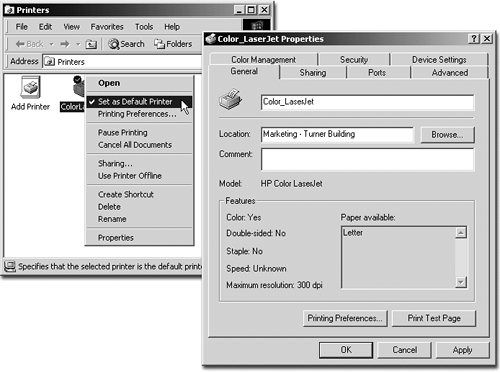When you're on a network, it's likely that no printer is plugged directly into your computer—but somewhere in the building, connected to your machine by cables, sits a shared printer (or several). To find out what printers you can use, choose Start→Settings→Printers; the Printers window opens, showing the icons for any printers whose software you've installed, along with an Add Printer icon.
If the printer icons all have cryptic names, right-click each in turn, selecting Properties from each shortcut menu. The resulting dialog box usually provides more information (see Figure 13-9) about the type of printer and where it is.
Figure 13-9. Left: The checkmark means this printer is the one your Windows programs will use by default (unless you specify a different printer). Right: If you right-click a printer and select Properties, you'll see all sorts of information about the printer (if your network administrator has supplied it), including its location and features.
If you're lucky enough to have several printers you can use, you need to set one as your default printer—the one your Windows printouts will go to unless you change the setting.
To specify your favorite printer, right-click its icon in the Printers window; choose Set As Default Printer from the shortcut menu (Figure 13-9, left).
When your generous manager buys a new printer for the network (and turns on Sharing for it), you'll be able to use it—but first you need to find it on the network and then tell your computer about it.
As noted on Section 2.2, Active Directory is a feature of Windows 2000 Server, the corporate-network version of Windows 2000. It's a central directory that lists (and lets administrators manage) applications, files, people—and printers.
If you work on an Active Directory-based network, you add a network printer to your Printers folder like this:
Choose Start → Settings → Printers. In the Printers window, double-click Add Printer.
The Add Printer wizard opens.
Click Next. Select Network Printer; click Next again.
Now you arrive at the Locate Your Printer screen.
If the "Find a printer in the Directory" option is available, select it and click Next.
If not, see the next section, "Locating a Printer by Browsing."
In the Find Printers dialog box, specify a printer name, location, or the features you need to use, if you like.
These options will help narrow the choices if you're in a big company. (Leave these fields blank if you want the search to list all of the printers in the directory.)
Click Find Now.
Windows 2000 contacts a domain controller on the network, which supplies a list of the printers that meet your criteria.
Highlight the name of the printer you want to add and click OK.
Indicate if this printer is to be your default printer. Click Next.
Review the choices you've made and click Finish.
Note
Selecting a network printer this way doesn't guarantee that the printer is turned on, functioning, filled with paper, or even physically there—only that it exists in the Active Directory. Check with your network administrator if you're unsure of which printer you should use.
Removing a printer from the Printers window is easy. Right-click the printer in the Printers folder and select Delete from the shortcut menu. After you confirm that you want to delete the printer's icon, it disappears.
If Active Directory isn't used on your network, you'll need to browse around to find the network printer you want. To do so, follow these steps.
Choose Start → Settings → Printers. In the Printers window, double-click Add Printer.
The Add Printer wizard opens.
Click Next. Select the Network Printer option and click Next again.
Now you arrive at the Locate Your Printer screen.
Select "Type the printer name." If you know the exact name that the printer has been given, type it in.
If not, click Next to browse for the printer. A list of shared printers on your network appears; highlight the one you want to add to your Printers window.
Click Next. Indicate if you want this printer to be your default printer. Click Next. Review the choices you've made and click Finish.
Once you've set up your machine to use the printers on your network, sending printouts to them isn't any more difficult than the everyday printing: With a document on the screen, choose File→Print, and proceed as described in Section 16.3.2.2.


